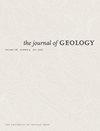年轻和年老的麻粒岩:一个易变的联系
IF 1.3
4区 地球科学
Q2 GEOLOGY
引用次数: 1
摘要
晚太古宙以来,下地壳的麻粒岩相变质作用规模有所减少,但其许多决定性特征仍然存在:(1)高级变质作用的间断,有时相对短暂。在非常简单的情况下,这些都是通过锆石上的离散生长边缘记录的。(2) 新生岩浆作用(地壳吸积)和高温变质作用之间持续存在几到几千万年的年龄差距。次生热脉冲是一种不同于原生地壳增生的事件。(3) 参与矿化H2O活性降低的孔隙流体,即具有高CO2和盐水浓度的孔隙流体。一些麻粒岩的极高氧化态表明硫是一种重要的流体成分。(4) 横贯断层作用是同变质变形的一个显著特征。这就产生了特征性的转置叶理和线理。(5) 中地壳水平的同时代造山后富钾花岗岩的安置。这些特征可以用现代板块构造的概念来合理化。高角度板块碰撞是造山带平行运动的结果。板块运动的这种变化必然会使岩石圈的逆冲部分分离,释放出造山后复活的软流圈熔体和/或流体。一代富含挥发性的镁铁质岩浆侵入大陆边缘;高CO2和卤素含量导致岩浆在深处放气和冻结。释放的挥发物通过浸出H2O和亲石元素(重要的是K),并将这些成分和热量向上输送,从而影响麻粒岩相变质作用。高压下含盐碳酸孔隙流体的低H2O活性抑制了下地壳的广泛熔融。当碱氯化物溶液的压力降至0.6–0.5 GPa以下时,由于H2O活性的增加,正片麻岩和表壳岩在中地壳水平发生熔融。上述假设是对经典观点的替代,即花岗岩是由下地壳中没有流体的部分熔融和提取产生的,留下麻粒岩。本文章由计算机程序翻译,如有差异,请以英文原文为准。
Young and Old Granulites: A Volatile Connection
Granulite facies metamorphism of the lower crust has decreased in scale since the Late Archean, but many of its definitive features have persisted: (1) Punctuated, sometimes relatively short-lived, episodes of high-grade metamorphism. These are recorded, in favorably simple cases, by discrete growth rims on zircons. (2) A consistent age gap of a few to several tens of millions of years between juvenile magmatism (crustal accretion) and high-temperature metamorphism. The secondary thermal pulse is an event distinct from primary crustal accretion. (3) Involvement of mineralizing pore fluids of lowered H2O activity, that is, with high CO2 and saline concentrations. Very high oxidation states of some granulites implicate sulfur as an important fluid component. (4) Transcurrent faulting as a conspicuous feature of synmetamorphic deformation. This gives rise to characteristic transposed foliation and lineation. (5) Emplacement of coeval postorogenic K-rich granites at midcrust levels. These features can be rationalized by concepts of modern plate tectonics. High-angle plate collision is succeeded by orogen-parallel transport. This change of plate motion necessarily detaches the underthrust portion of the lithosphere, liberating asthenospheric melts and/or fluids in a postorogenic resurgence. A generation of volatile-rich mafic magmas invades the continental margin; high CO2 and halogen contents cause outgassing and freezing of the magmas at depth. Liberated volatiles effect granulite facies metamorphism by leaching H2O and lithophile elements, importantly K, and transporting these components and heat upward. Extensive melting of the lower crust is inhibited by the low H2O activity of saline-carbonic pore fluids at high pressure. Melting of orthogneiss and supracrustal rocks occurs at midcrust levels by increase of H2O activity as pressure on alkali chloride solutions falls below 0.6–0.5 GPa. The foregoing hypothesis is an alternative to the classical view that granite results from fluid-absent partial melting of, and extraction from, the lower crust, leaving granulites.
求助全文
通过发布文献求助,成功后即可免费获取论文全文。
去求助
来源期刊

Journal of Geology
地学-地质学
CiteScore
3.50
自引率
5.60%
发文量
0
审稿时长
3 months
期刊介绍:
One of the oldest journals in geology, The Journal of Geology has since 1893 promoted the systematic philosophical and fundamental study of geology.
The Journal publishes original research across a broad range of subfields in geology, including geophysics, geochemistry, sedimentology, geomorphology, petrology, plate tectonics, volcanology, structural geology, mineralogy, and planetary sciences. Many of its articles have wide appeal for geologists, present research of topical relevance, and offer new geological insights through the application of innovative approaches and methods.
 求助内容:
求助内容: 应助结果提醒方式:
应助结果提醒方式:


